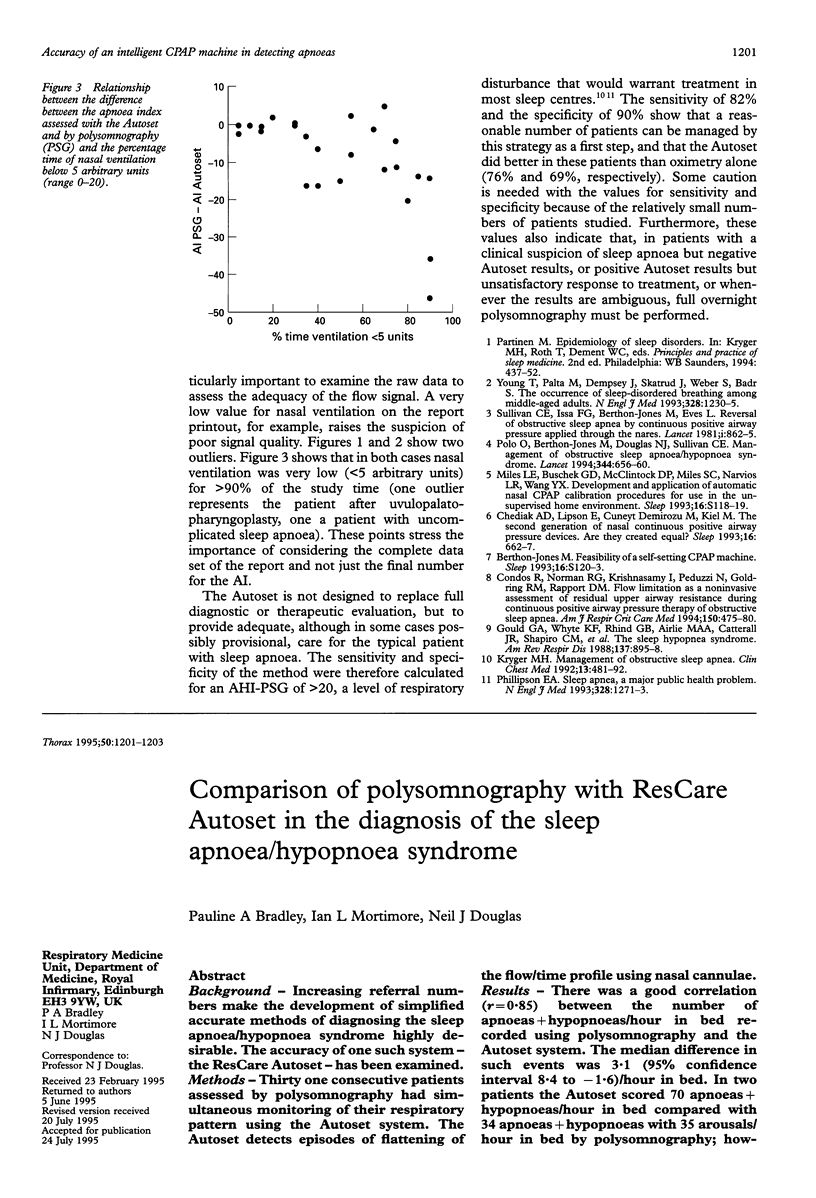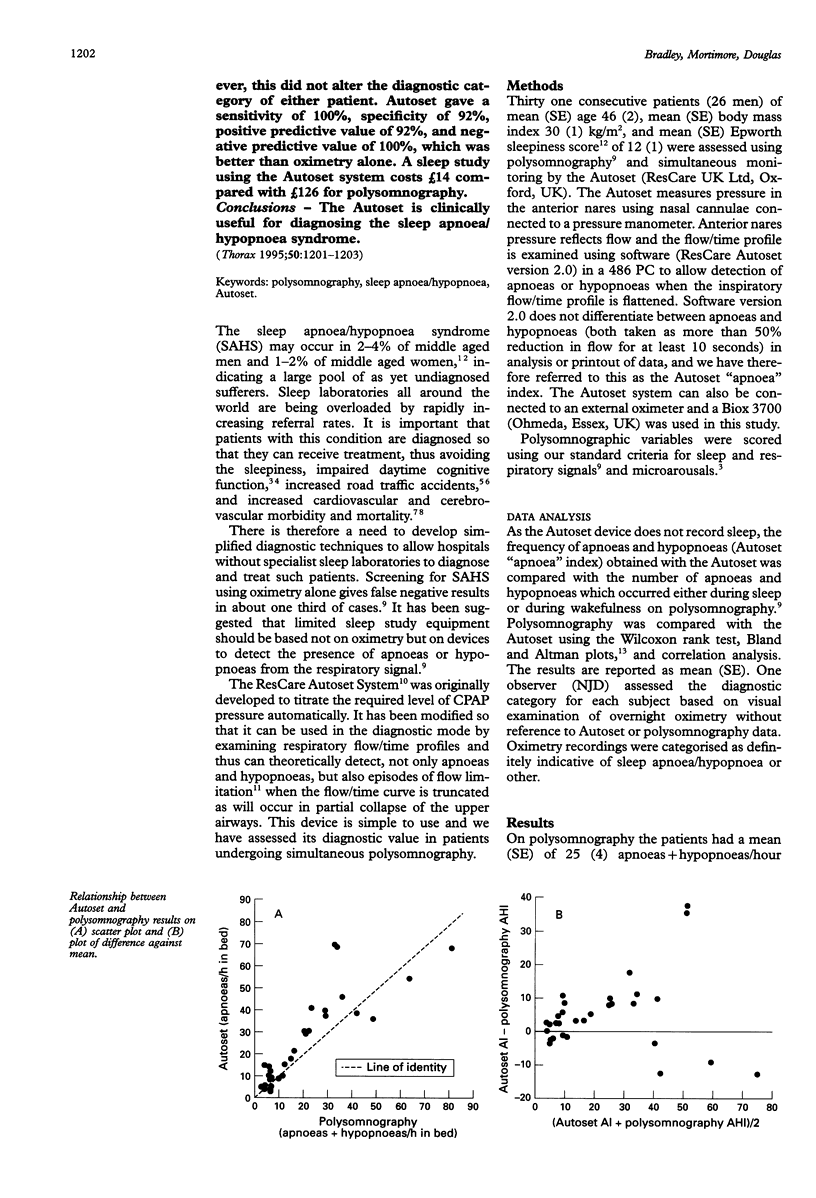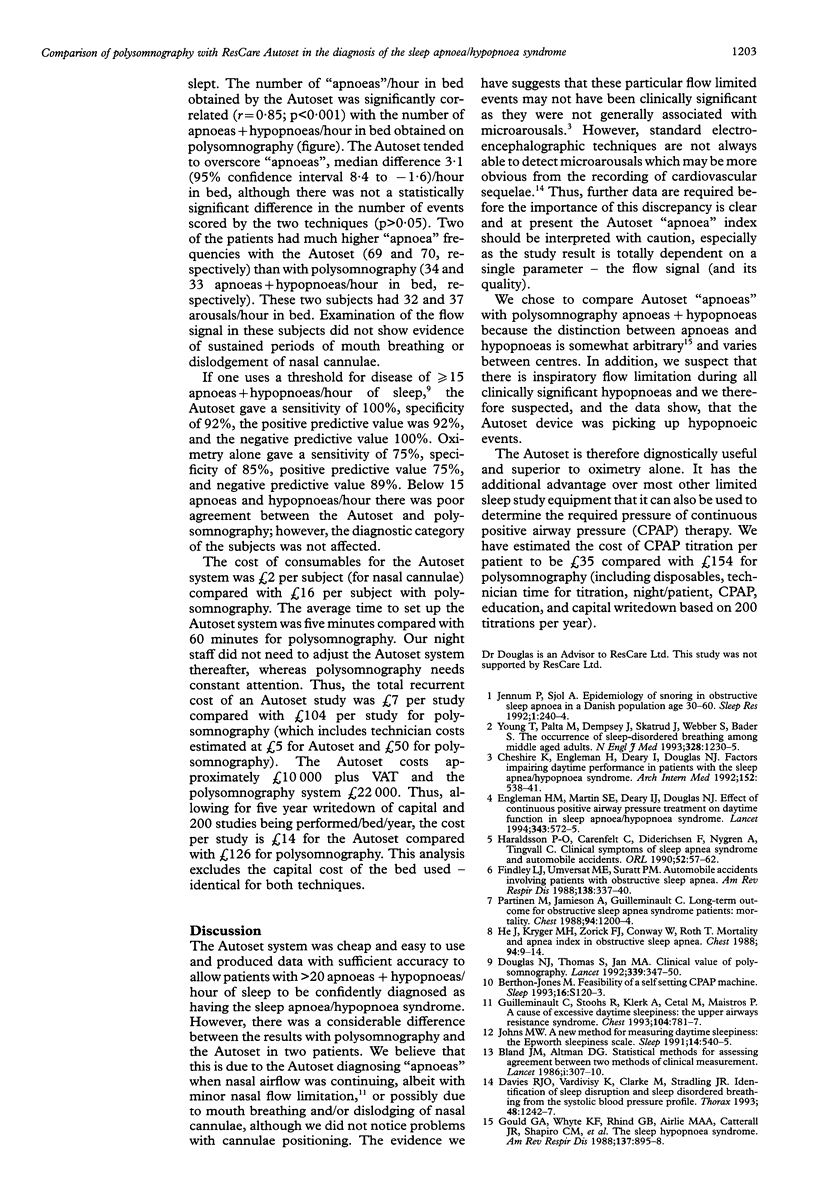Abstract
BACKGROUND--Increasing referral numbers make the development of simplified accurate methods of diagnosing the sleep apnoea/hypopnoea syndrome highly desirable. The accuracy of one such system--the ResCare Autoset--has been examined. METHODS--Thirty one consecutive patients assessed by polysomnography had simultaneous monitoring of their respiratory pattern using the Autoset system. The Autoset detects episodes of flattening of the flow/time profile using nasal cannulae. RESULTS--There was a good correlation (r = 0.85) between the number of apnoeas+hypopnoeas/hour in bed recorded using polysomnography and the Autoset system. The median difference in such events was 3.1 (95% confidence interval 8.4 to -1.6)/hour in bed. In two patients the Autoset scored 70 apnoeas+hypopnoeas/hour in bed compared with 34 apnoeas+hypopnoeas with 35 arousals/hour in bed by polysomnography; however, this did not alter the diagnostic category of either patient. Autoset gave a sensitivity of 100%, specificity of 92%, positive predictive value of 92%, and negative predictive value of 100%, which was better than oximetry alone. A sleep study using the Autoset system costs 14 pounds compared with 126 pounds for polysomnography. CONCLUSIONS--The Autoset is clinically useful for diagnosing the sleep apnoea/hypopnoea syndrome.
Full text
PDF


Selected References
These references are in PubMed. This may not be the complete list of references from this article.
- Berthon-Jones M. Feasibility of a self-setting CPAP machine. Sleep. 1993 Dec;16(8 Suppl):S120–S123. doi: 10.1093/sleep/16.suppl_8.s120. [DOI] [PubMed] [Google Scholar]
- Bland J. M., Altman D. G. Statistical methods for assessing agreement between two methods of clinical measurement. Lancet. 1986 Feb 8;1(8476):307–310. [PubMed] [Google Scholar]
- Cheshire K., Engleman H., Deary I., Shapiro C., Douglas N. J. Factors impairing daytime performance in patients with sleep apnea/hypopnea syndrome. Arch Intern Med. 1992 Mar;152(3):538–541. [PubMed] [Google Scholar]
- Davies R. J., Vardi-Visy K., Clarke M., Stradling J. R. Identification of sleep disruption and sleep disordered breathing from the systolic blood pressure profile. Thorax. 1993 Dec;48(12):1242–1247. doi: 10.1136/thx.48.12.1242. [DOI] [PMC free article] [PubMed] [Google Scholar]
- Douglas N. J., Thomas S., Jan M. A. Clinical value of polysomnography. Lancet. 1992 Feb 8;339(8789):347–350. doi: 10.1016/0140-6736(92)91660-z. [DOI] [PubMed] [Google Scholar]
- Engleman H. M., Martin S. E., Deary I. J., Douglas N. J. Effect of continuous positive airway pressure treatment on daytime function in sleep apnoea/hypopnoea syndrome. Lancet. 1994 Mar 5;343(8897):572–575. doi: 10.1016/s0140-6736(94)91522-9. [DOI] [PubMed] [Google Scholar]
- Findley L. J., Unverzagt M. E., Suratt P. M. Automobile accidents involving patients with obstructive sleep apnea. Am Rev Respir Dis. 1988 Aug;138(2):337–340. doi: 10.1164/ajrccm/138.2.337. [DOI] [PubMed] [Google Scholar]
- Gould G. A., Whyte K. F., Rhind G. B., Airlie M. A., Catterall J. R., Shapiro C. M., Douglas N. J. The sleep hypopnea syndrome. Am Rev Respir Dis. 1988 Apr;137(4):895–898. doi: 10.1164/ajrccm/137.4.895. [DOI] [PubMed] [Google Scholar]
- Guilleminault C., Stoohs R., Clerk A., Cetel M., Maistros P. A cause of excessive daytime sleepiness. The upper airway resistance syndrome. Chest. 1993 Sep;104(3):781–787. doi: 10.1378/chest.104.3.781. [DOI] [PubMed] [Google Scholar]
- Haraldsson P. O., Carenfelt C., Diderichsen F., Nygren A., Tingvall C. Clinical symptoms of sleep apnea syndrome and automobile accidents. ORL J Otorhinolaryngol Relat Spec. 1990;52(1):57–62. doi: 10.1159/000276104. [DOI] [PubMed] [Google Scholar]
- He J., Kryger M. H., Zorick F. J., Conway W., Roth T. Mortality and apnea index in obstructive sleep apnea. Experience in 385 male patients. Chest. 1988 Jul;94(1):9–14. [PubMed] [Google Scholar]
- Jennum P, Sjøl A. Epidemiology of snoring and obstructive sleep apnoea in a Danish population, age 30-60. J Sleep Res. 1992 Dec;1(4):240–244. doi: 10.1111/j.1365-2869.1992.tb00045.x. [DOI] [PubMed] [Google Scholar]
- Johns M. W. A new method for measuring daytime sleepiness: the Epworth sleepiness scale. Sleep. 1991 Dec;14(6):540–545. doi: 10.1093/sleep/14.6.540. [DOI] [PubMed] [Google Scholar]
- Partinen M., Jamieson A., Guilleminault C. Long-term outcome for obstructive sleep apnea syndrome patients. Mortality. Chest. 1988 Dec;94(6):1200–1204. doi: 10.1378/chest.94.6.1200. [DOI] [PubMed] [Google Scholar]
- Young T., Palta M., Dempsey J., Skatrud J., Weber S., Badr S. The occurrence of sleep-disordered breathing among middle-aged adults. N Engl J Med. 1993 Apr 29;328(17):1230–1235. doi: 10.1056/NEJM199304293281704. [DOI] [PubMed] [Google Scholar]


